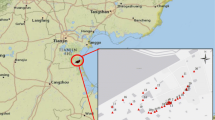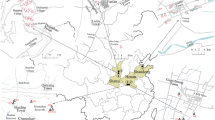Abstract
Soil and groundwater contamination around a fuel distribution station in Tomiño (NW Spain) was evaluated. For this purpose, top and subsoil (up to 6.4 m) and groundwater were sampled around the station, approximately in a 60-m radius. Samples were analysed by HS-SPME-GC-MS to identify and quantify volatile fuel organic compounds (VFOC) (MTBE, ETBE and BTEX) and diesel range organics (DRO). Analysis and fingerprinting data suggested that the contamination of soil and groundwater was provoked by a fuel leak from underground storage tanks. This was reflected by hydrocarbon indices and principal component analysis, which discriminated a direct source of contamination of the subsoil samples around the station. The contaminants probably migrated from tank nearby soils to surrounding soils and leached to groundwater, following a SW direction. Irrigation with contaminated groundwater provoked a severe contamination of topsoils, which were enriched with the lightest components of gasoline and diesel. Fingerprinting also revealed the continuity of the leak, reflected by the presence of volatiles in some samples, which principally appeared in fresh leaks. MTBE was detected in a very high concentration in groundwater samples (up to 690 μg L−1), but it was not detected in fresh gasoline. This also evidenced an old source of contamination, probably starting in the mid-1990s, when the use of MTBE in gasoline was regulated.




Similar content being viewed by others
References
Alimi, H., Ertel, T., & Schug, B. (2003). Fingerprinting of hydrocarbon fuel contaminants: literature review. Environmental Forensics, 4(1), 25–38.
Al-Mutairi, N., Bufarsan, A., & Al-Rukaibi, F. (2008). Ecorisk evaluation and treatability potential of soils contaminated with petroleum hydrocarbon-based fuels. Chemosphere, 74(1), 142–148.
Arey, J. S., & Gschwend, P. M. (2005). A physical–chemical screening model for anticipating widespread contamination of community water supply wells by gasoline constituents. Journal of Contaminant Hydrology, 76(1–2), 109–138.
Asquith, E. A., Geary, P. M., Nolan, A. L., & Evans, C. A. (2012). Comparative bioremediation of petroleum hydrocarbon-contaminated soil by biostimulation, bioaugmentation and surfactant addition. Journal of Environmental Science and Engineering A, 1, 637–650.
Atienza, J., Aragón, P., Herrero, M. A., Puchades, R., & Maquieira, Á. (2005). State of the art in the determination of MTBE in natural waters and soils. Critical Reviews in Analytical Chemistry, 35(4), 317–337.
Barth, J. A. C., Grathwohl, P., Fowler, H. J., Bellin, A., Gerzabek, M. H., Lair, G. J., et al. (2009). Mobility, turnover and storage of pollutants in soils, sediments and waters: achievements and results of the EU project AquaTerra. A review. Agronomy for Sustainable Development, 29(1), 161–173.
Chen, F., Taylor, W. D., Anderson, W. B., & Huck, P. M. (2013). Application of fingerprint-based multivariate statistical analyses in source characterization and tracking of contaminated sediment migration in surface water. Environmental Pollution, 179, 224–231.
Christophersen, M., Broholm, M. M., Mosbæk, H., Karapanagioti, H. K., Burganos, V. N., & Kjeldsen, P. (2005). Transport of hydrocarbons from an emplaced fuel source experiment in the vadose zone at Airbase Værløse, Denmark. Journal of Contaminant Hydrology, 81(1–4), 1–33.
Day, M. J., Reinke, R. F., & Thomson, J. A. M. (2001). Fate and transport of fuel components below slightly leaking underground storage tanks. Environmental Forensics, 2(1), 21–28.
European Fuel Oxygenates Association (EFOA). (2006). MTBE. Resource guide. www.efoa.eu.
Faure, P., Mansuy-Huault, L., & Su, X. (2007). Alkanes and hopanes for pollution source apportionment in coking plant soils. Environmental Chemistry Letters, 5(1), 41–46.
Fine, P., Graber, E. R., & Yaron, B. (1997). Soil interactions with petroleum hydrocarbons: abiotic processes. Soil Technology, 10(2), 133–153.
Food and Agriculture Organization of the United Nations (FAO). IUSS Working Group WRB. (2006). World reference base for soil resources. World Soil Resources Reports No. 103. Rome: FAO.
García Pinto, C., Herrero Martín, S., Pérez Pavón, J. L., & Moreno, C. B. (2011). A simplified Quick, Easy, Cheap, Effective, Rugged and Safe approach for the determination of trihalomethanes and benzene, toluene, ethylbenzene and xylenes in soil matrices by fast gas chromatography with mass spectrometry detection. Analytica Chimica Acta, 689(1), 129–136.
Gerzabek, M. H., Barceló, D., Bellin, A., Rijnaarts, H. H. M., Slob, A., Darmendrail, D., et al. (2007). The integrated project AquaTerra of the EU sixth framework lays foundations for better understanding of river–sediment–soil–groundwater systems. Journal of Environmental Management, 84(2), 237–243.
Gocht, T., Barth, J. A. C., Epp, M., Jochmann, M., Blessing, M., Schmidt, T. C., & Grathwohl, P. (2007). Indications for pedogenic formation of perylene in a terrestrial soil profile: depth distribution and first results from stable carbon isotope ratios. Applied Geochemistry, 22(12), 2652–2663.
Gómez-Canela, C., Barth, J. C., & Lacorte, S. (2012). Occurrence and fate of perfluorinated compounds in sewage sludge from Spain and Germany. Environmental Science and Pollution Research, 19(9), 4109–4119.
Gong, Y., Zhao, X., Cai, Z., O’Reilly, S. E., Hao, X., & Zhao, D. (2014). A review of oil, dispersed oil and sediment interactions in the aquatic environment: influence on the fate, transport and remediation of oil spills. Marine Pollution Bulletin, 79(1–2), 16–33.
Goss, K. U., & Schwarzenbach, R. P. (2003). Rules of thumb for assessing equilibrium partitioning of organic compounds: success and pitfalls. Journal of Chemical Education, 80(4), 450–455.
Hamill, N. A., Hardacre, C., Barth, J. A. C., Kalin, R. M., & Cunningham, J. F. (2001). Gas-phase photocatalytic oxidation of dichlorobutenes. Environmental Science & Technology, 35(13), 2823–2827.
Harji, R. R., Yvenat, A., & Bhosle, N. B. (2008). Sources of hydrocarbons in sediments of the Mandovi estuary and the Marmugoa harbour, west coast of India. Environment International, 34(7), 959–965.
Iturbe, R., Flores, C., Flores, R. M., & Torres, L. G. (2005). Subsoil TPH and other petroleum fractions-contamination levels in an oil storage and distribution station in north-central Mexico. Chemosphere, 61(11), 1618–1631.
Macías, F. (2007). Analysis of gasoline additives in groundwater around a fuel distribution station in Tomiño (Spain). Technical Report.
Mackay, D., Shiu, W. Y., Ma, K. C., & Lee, S. C. (2006). Handbook of physical-chemical properties and environmental fate for organic chemicals. Boca Raton: CRC Press.
Mulabagal, V., Yin, F., John, G. F., Hayworth, J. S., & Clement, T. P. (2013). Chemical fingerprinting of petroleum biomarkers in Deepwater Horizon oil spill samples collected from Alabama shoreline. Marine Pollution Bulletin, 70(1–2), 147–154.
Paíga, P., Mendes, L., Albergaria, J. T., & Delerue-Matos, C. (2012). Determination of total petroleum hydrocarbons in soil from different locations using infrared spectrophotometry and gas chromatography. Chemical Papers, 66(8), 711–721.
Saravanabhavan, G., Helferty, A., Hodson, P. V., & Brown, R. S. (2007). A multi-dimensional high performance liquid chromatographic method for fingerprinting polycyclic aromatic hydrocarbons and their alkyl-homologs in the heavy gas oil fraction of Alaskan North Slope crude. Journal of Chromatography A, 1156(1–2), 124–133.
Serrano, A., Gallego, M., González, J. L., & Tejada, M. (2008). Natural attenuation of diesel aliphatic hydrocarbons in contaminated agricultural soil. Environmental Pollution, 151(3), 494–502.
Stout, S. A. (2003). Applications of petroleum fingerprinting in known and suspected pipeline releases—two case studies. Applied Geochemistry, 18(6), 915–926.
Trapp, S., Köhler, A., Larsen, L., Zambrano, K., & Karlson, U. (2001). Phytotoxicity of fresh and weathered diesel and gasoline to willow and poplar trees. Journal of Soils and Sediments, 1(2), 71–76.
United States Environmental Protection Agency (USEPA). (1997). Drinking water advisory: consumer acceptability advice and health effects analysis on methyl tertiary-butyl ether (MTBE). Washington: US Environmental Protection Agency.
United States Environmental Protection Agency (USEPA). (2003). Method 5021A: volatile organic compounds in various sample matrices using equilibrium headspace analysis. Revision 1. Washington: US Environmental Protection Agency.
United States Environmental Protection Agency (USEPA). (2007a). Method 8015C: Nonhalogenated organics by gas chromatography. Revision 3. Washington: US Environmental Protection Agency.
United States Environmental Protection Agency (USEPA). (2007b). Method 8270D: Semivolatile organic compounds by gas chromatography/mass spectrometry (GC/MS). Revision 4. Washington: US Environmental Protection Agency.
United States Environmental Protection Agency (USEPA). Method 8260C: Volatile organic compounds by gas chromatography/mass spectrometry (GC/MS). (2006). Revision 3. Washington: US Environmental Protection Agency.
Wang, Z., & Fingas, M. (1997). Developments in the analysis of petroleum hydrocarbons in oils, petroleum products and oil-spill-related environmental samples by gas chromatography. Journal of Chromatography A, 774(1–2), 51–78.
Wang, Z., Fingas, M., & Page, D. S. (1999). Oil spill identification. Journal of Chromatography A, 843(1–2), 369–411.
Wang, Z., Stout, S. A., & Fingas, M. (2006). Forensic fingerprinting of biomarkers for oil spill characterization and source identification. Environmental Forensics, 7(2), 105–146.
Zawrah, M. F., Ebiad, M. A., Rashad, A. M., El-Sayed, E., Snousy, M., & Tantawy, M. A. (2014). GC estimation of organic hydrocarbons that threaten shallow Quaternary sandy aquifer Northwestern Gulf of Suez, Egypt. Environmental Monitoring and Assessment, 186(11), 7579–7591.
Zhang, J., Dai, J., Chen, H., Du, X., Wang, W., & Wang, R. (2012). Petroleum contamination in groundwater/air and its effects on farmland soil in the outskirt of an industrial city in China. Journal of Geochemical Exploration, 118, 19–29.
Acknowledgments
This research was supported by the Galician Government (Consellería de Innovación e Industria of Xunta de Galicia) (INCITE08PXIB200136PR) and by the Spanish Government (Ministerio de Economía y Competitividad) and FEDER (CTM2009-14576-C02-02 and PhD grant for M. Balseiro BES-2010-030923).
Author information
Authors and Affiliations
Corresponding author
Rights and permissions
About this article
Cite this article
Balseiro-Romero, M., Macías, F. & Monterroso, C. Characterization and fingerprinting of soil and groundwater contamination sources around a fuel distribution station in Galicia (NW Spain). Environ Monit Assess 188, 292 (2016). https://doi.org/10.1007/s10661-016-5288-1
Received:
Accepted:
Published:
DOI: https://doi.org/10.1007/s10661-016-5288-1




